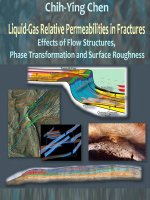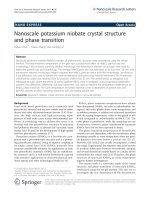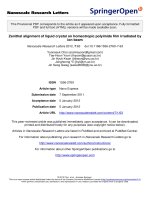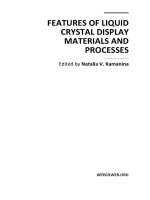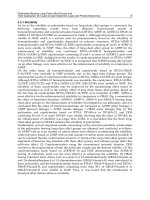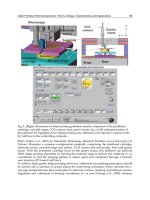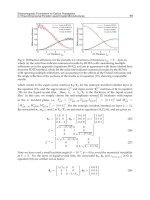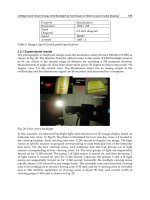Optically isotropic ferroelectric liquid crystal phase
Bạn đang xem bản rút gọn của tài liệu. Xem và tải ngay bản đầy đủ của tài liệu tại đây (666.97 KB, 9 trang )
electronic-Liquid Crystal Communications
May 13, 2004
Optically isotropic ferroelectric liquid crystal phase
G. Liao1, S. Stojadinovic2, G. Pelzl3, W. Weissflog,3 S. Sprunt2, A. Jákli1
1
Liquid Crystal Institute, Kent State University, Kent, OH 44242, USA;
e-mail:
2
Department of Physics, Kent State University, Kent, OH 44242, USA;
e-mail:
3
Institut für Physikalishe Chemie, Martin Luther Universitat, Halle-Wittenberg, Mühlpforte 1, D06108, Halle (Saale), Germany; e-mail:
We show that the optically isotropic phase observed recently in a bent core liquid crystal
material, 4-chlororesorcinol bis[4-(4-n-dodecyloxybenzoyloxy)benzoate], is ferroelectric.
Polarizing microscopic, electric current and dynamic light scattering studies reveal that the
structure in the ferroelectric phase consists of weakly interconnected orthoconic racemic smectic
(SmCaPF) granules with random layer directions.
I. Introduction
The discovery of the mesogenic properties of bent-core molecules has opened up a major
new and exciting direction in the science of thermotropic liquid crystals (LCs). Seminal findings
– with broad implications for the general field of soft condensed matter – include the observation
of (anti)ferroelectricity and spontaneous chiral symmetry breaking in phases that are solid-like in
one-dimension (smectic phases) but are composed of molecules that are not intrinsically chiral
themselves. [1,2,3,4] To date, most of the research effort has focused on bent-core smectics5,
mainly since nematic phases are rather uncommon in bent-core compounds. This is because the
translational freedom required for a nematic phase is typically favored when the molecules can
rotate relatively freely around their long axis, a property that is not readily compatible with bentshaped molecules. Indeed, the viscosities associated with both director rotations and flow in the
optically uniaxial nematic phase of bent shape molecules [6,7,8,9] are unusually high, a feature
that has led to the suggestion of a structure consisting of smectic “cybotactic” groups even far
away from a smectic phase. [10,11] The entropy loss arising from cybotactic groups can be
compensated by an energy reduction associated with the close packing of bent-core molecules
achieved by a locally layered structure; the close packing in turn implies a polar molecular
arrangement within the individual cybotactic groups. Since the cybotactic groups are
uncorrelated and perpetually changing, we do not expect macroscopic polarization in the nematic
phase. However, we can expect the formation of a polar smectic phase below the nematic. A few
examples found recently include N-SmA-SmC-SmCP [7,12] and N-SmCP [8,13,14]
polymorphisms. In these cases the SmCP phases were antiferroelectric and birefringent.
Very recently Pelzl et al. [15] and Weissflog et al. [16] have reported a material 4chlororesorcinol bis[4-(4-n-dodecyloxybenzoyloxy)benzoate] (4-CBDB) with an unusual
transition from a nematic phase to an optically isotropic mesophase (OIM) with local smectic
structure. Its phase sequence is the following: (I 95oC N OIM 80oC) Cr 98oC. The presence of
cybotactic smectic groups was observed in the entire nematic range. The monotropic, optically
isotropic smectic phase that appears below the nematic phase on cooling has a correlation length
1
/>Tai ngay!!! Ban co the xoa dong chu nay!!!
electronic-Liquid Crystal Communications
May 13, 2004
of only about 11 nm. The director tilt angle was found to be about 45o both in the smectic phase
and in the cybotactic groups of the nematic phase. The angle between the molecular arms
(opening angle) was estimated as 140o in the nematic phase. It was also pointed out that in
several aspects OIM is similar to the so-called smectic blue phases.17 They are weakly
birefringent (∆n~10-3 for Bp Sm1 and ∆n~10-4 for BpSm2). Their smectic correlation length
(~20-60nm) is also similar to the correlation lengths (~11nm) observed in the isotropic
mesophase of 4-CBDB. However, there are also a number of profound differences. First of all,
the Sm blue phases appear below the isotropic and above a TGB phase, whereas the isotropic
mesophase of 4-CBDB lies below the nematic and above a crystal phase. Second, blue phases
are strongly related to chirality, whereas in 4-CBDB only weak optical activity is observed in
cells thicker than 6-10µm. Finally, the X-ray profiles of Sm blue phases show definite peaks, and
not the uniform ring that persists into the isotropic mesophase of 4-CBDB.
In this letter we report additional investigations on 4-CBDB and, in particular, show that
the optically isotropic phase, just below the nematic, is ferroelectric, which, to our best
knowledge, is the first account of an isotropic ferroelectric liquid crystal mesophase. Electric
current, dynamic light scattering and polarizing microscopic measurements lead us to conclude
that the ferroelectric phase consists of randomly aligned, roughly 10 nm size orthoconic
anticlinic racemic smectic (SmCaPF) granules.
a
b
c
d
Figure 1: Typical textures of a 4µm thick sample of 4-CBDB contained in an electro-optic cell treated for
homogeneous alignment of the nematic director. Pictures show 75µm x 100µm areas imaged through crossed
polarizer and analyzer. Upper row: Textures in the nematic phase at zero fields (a), and under ac fields (f=
580Hz E=12.5V/µm) (b). Lower row: Textures just below the nematic phase: E=0, T=80oC (c); T=79oC,
electrode and non-electrode area (d), with E=0 but after a E=12.5V/µm, f=12Hz square wave field was
applied for 10 seconds. The system has stabilized into an optically isotropic state. Arrow indicates the rubbing
direction. The polarizers are set in the horizontal and vertical directions.
2
/>
electronic-Liquid Crystal Communications
May 13, 2004
10
o
5
100
0
0
-5
-100
a
-10
-0.03
-0.01
0.01
16V/µm
20V/µm
32V/µm
42V/µm
10
Current (arb. unit)
80 C
79C
o
78 C
o
77 C
Applied voltage (V)
Polarization current (arb. unit)
Samples of 4-CBDB were loaded into standard electro-optic cells treated with rubbed
alignment layers for homogeneous alignment of the nematic director. After cycling through the
isotropic liquid, we observed uniform nematic alignment, with the optical axis oriented along the
rubbing direction, over the entire nematic range. However, when electric fields are applied, the
textures become inhomogeneous. As reported previously [15,16], under DC fields a domain
texture, similar to a smectic phase, appears (Figure 1/a). Under AC fields, however, the patterned
texture is suggestive of electrohydrodynamic instability (Figure 1/b). On cooling from the
nematic phase there is a 1oC range starting at 80oC, when the optically isotropic areas are
decorated with birefringent filaments (Figure 1/c). This range indicates a coexistence of the
nematic and lower temperature isotropic mesophase. On further cooling, or after applying
electric fields of E > 10V/µm for a few seconds, the texture becomes completely black between
crossed polarizers (Figure 1/d).
0
-10
b
0
0.03
Time (sec)
Time (sec)
0.65
Switching time (ms)
2
P (nC/cm )
600
400
200
c
0
0.02
0
10
20
30
40
0.55
0.50
0.45
0.40
18
50
data
1.25
τ=23.9/E
0.60
d
20
22
24
26
Electric field (V/µm)
Electric field (V/µm)
Figure 2: Summary of the electric current measurements made on a 4µm thick sample in the isotropic
ferroelectric mesophase of 4-CBDB. (a) Time dependent response at different temperatures under triangular
voltages (E= 25V/µm); (b) Time dependent response at T=77oC under triangular voltages of different
amplitudes; (c) The field dependence of the polarization at 77oC; (d) The field dependence of the switching
time as determined by the current peak position under square wave fields at 77oC.
We next performed electric current measurements using triangular electric fields. Above
~8V/µm, we observe the appearance of single peaks in the current in each half period (Figure 2/a
and b), which is a clear indication for ferroelectric type polarization switching. The peaks
completely disappear in the nematic phase, which rules out the influence of ionic effects and
3
/>
electronic-Liquid Crystal Communications
May 13, 2004
assures the ferroelectric origin of the observations. The temperature and electric field
dependence of the electric current are shown in Figure 2/a and b, respectively.
The polarization deduced from the current measurements reaches a maximum of about
500nC/cm2 (Figure 2/c) at T=77oC and E just above 40V/µm. At lower temperatures the
polarization measured at a fixed 40V/µm field decreases, but is still measurable down to 64oC.
The apparent decrease is due a continuous shift to higher E of the polarization switching
threshold and saturation point with decreasing temperatures. At temperatures more than 2oC
below the transition from the nematic phase, the switching of the polarization occurred without
any electro-optical response that could be detected in the polarizing microscope.
Figure 3: Summary of light scattering measurements. (a) Depolarized transmission of a normally incident
HeNe laser beam through 4 µm sample of 4-CBDB as a function of the angle χ between the cell alignment
direction and the polarizer axis in the nematic phase (black circles), in the coexistence region (black squares),
and in the isotropic mesophase (black triangles). (b) Typical intensity-intensity correlation functions
<I(0)I(t)> taken on a 4 µm sample in the nematic phase (open circles) at T=880C, in the coexistence region
(open squares) at 790C and in the isotropic mesophase (open triangles) at 770C. The scattering vector is 65,000
cm−1 along the optic axis. (c) Temperature dependence of the relaxation rate Γ of nematic director
fluctuations in a homogeneously-aligned 4 µm sample without electric field. Open circles represent nematic –
isotropic mesophase coexistence while black circles show nematic phase. (d) Top graph: Depolarized
<I(0)I(t)> obtained on a 4 µm sample in the optically isotropic mesophase with an applied 0.05 Hz sinusoidal
electric field. The scattering vector is 17,000 cm−1. Open circles represent regions where it was possible to
detect an electro-optical response, while open squares indicate the lack of any measurable signal in other
regions. Bottom graph: Normalized amplitude of the oscillatory component of <I(0)I(t)> as a function of
applied voltage, revealing a linear response to applied E with a small quadratic contribution.
4
/>
electronic-Liquid Crystal Communications
May 13, 2004
Light scattering studies were also performed in order to test for optical anisotropy in the
lower temperature mesophase with greater sensitivity. As Figures 3/a and b show, below the
coexistence region and in the case of zero applied field, there is no evidence of anisotropy either
in the depolarized forward transmission of normally incident laser light or in the time correlation
function of depolarized intensity fluctuations measured at a scattering vector 65,000 cm-1 along
the initial (nematic) optic axis. These measurements were taken on cooling a 4 µm thick,
homogeneously aligned sample of 4-CBDB from the nematic phase. From the data in Figure 3/a,
we estimate at least a 100-fold reduction in ∆n (measured for normal incidence) in the lower
temperature mesophase from the value in the nematic phase. Figure 3/c shows that similar to
other bent-core nematic materials [10], the relaxation rate Γ of director fluctuations is nearly two
orders of magnitudes smaller than for ordinary calamitic nematics. This can be explained by
enhanced rotational viscosities that would arise due to cybotactic groups. The temperature
dependence of Γ is basically consistent with an activated viscosity, and reveals a first order
transition, through a significant coexistence region, to the lower temperature isotropic
mesophase.
The experimental results reported above, together with previous X-ray, NMR and
dielectric observations [15,16], enable us to describe the structures of the nematic and isotropic
mesophase. The nematic phase can be pictured as a conglomerate of skewed cybotactic groups of
limited smectic layer correlation length but with layers orientationally ordered on average. The
overall uniaxial nematic behavior implies that the morphology of the cybotactic groups fluctuates
rapidly such that in-layer orientational order (and polarization) associated with close-packed bent
cores is averaged out over short lengths. Upon cooling, the number of the coherently packed
layers increase, and the local morphology stabilizes, resulting in a distribution of stable smectic
grains (“granules”). The loss of optical anisotropy, at least for normal incidence of light, can be
explained by the observed nearly 45o tilt angle combined with an anticlinic tilting between
layers, similar to anticlinic antiferroelectric calamitic smectic materials.18 Such an orthoconic
antiferroelectric structure was also recently found in bent-core smectics (with long range layer
correlations). [19] In that case the smectic material was antiferroelectric and with strong electric
fields it could be switched to a birefringent ferroelectric state, furthermore the optical isotropy
was due to a nearly 109.5o opening angle of the bent cores [20,21].
In contrast, the isotropic mesophase of 4-CBDB is ferroelectric, i.e. the anticlinic
structure cannot be switched over to a synclinic state. Therefore the orthoconic arrangement
remains undistorted upon switching the sign of polarization, explaining the absence of electrooptical signal. The observed switching of the polarization can happen via rotating the molecules
around the layer normal, or by rotation around their long axis (in the direction along the end–to–
end distance). In the former case the chirality of each layer is conserved. In the second case the
chirality of each layer changes sign, but the overall chirality remains racemic.
Note that anticlinic director order is not compatible with the uniform surface alignment
(if the director is along the rubbing direction in one layer, it would be almost perpendicular in the
neighboring layers). Accordingly, at the transition from nematic to the lower temperature
mesophase (where the smectic density wave increases somewhat), the surface will decouple from
the bulk, leaving a thin melted surface layer. Within the bulk, the layer orientation in the
different smectic granules will be arbitrary. Although the individual granules may be birefringent
(the tilt angle is not exactly 45o and the opening angle can be far from 109.5o), the optical axes
will be randomly oriented in a length scale much smaller than the wavelength of the visible light,
so the material will be optically isotropic similar to that observed recently by Ortega et al. [22]
5
/>
electronic-Liquid Crystal Communications
May 13, 2004
As Figure 3/b indicates, no dynamic light scattering signal is observed in this state, presumably
because the granules are static objects, cannot freely rotate, and perhaps are even weakly bonded
into local networks. When we apply a sufficiently strong electric field, these bonds will break,
and the granules will be reoriented (due to the torque acting on the polar axes of the granules), so
that everywhere the smectic layers are parallel to the electric field (bookshelf orientation). In the
plane normal to the field the layers orientation would be still arbitrary, thus maintaining the
optical isotropy for normal incidence. After repeated exposure to the field (or “annealing” in the
field), the bookshelf orientation will be everywhere established, and subsequent applications of
the electric field will not exert a torque on the layers; the switching of the polarization will
involve only the rotation of the director within the layers as described above.
Figure 4: Sketch of the model of the optically isotropic ferroelectric phase. Lines within the smectic granules
indicate the layer planes. Enlarged we show the local director structure and molecular polarization direction
within the smectic layers. Above a threshold field, the layers assume bookshelf geometry; however, the layer
normals between granules remain randomly oriented in the plane of the cell.
Light scattering induced by an applied AC field (Figure 3/d) confirms several aspects of
this picture. The scattering is very weak (>100-fold reduction in intensity compared to the
nematic), even in a substantial field, and was only observable at particular spots on the sample
(which seemed randomly distributed). This result is consistent with only a weak modulation in
optical anisotropy when driving the system from 3D-random granular to the bookshelf
configuration. The amplitude of the oscillations on the intensity correlation function in Figure
3/d (induced by the oscillatory applied field and measured in the heterodyne regime) has a
combined linear and quadratic dependence on E, consistent with polar (ferroelectric) switching
and a secondary role played by the molecular dielectric anisotropy, which is negative (~-2). We
also find a threshold field for observable light scattering that is consistent with the threshold to
achieve the initial transition to bookshelf in the polarization data. Finally, the field-induced
scattering confirms the annealing effect: after sufficient time (<1 to several hours, depending on
the spot) in fields ~10 V/µm or higher, the signal always began to drop and eventually disappear.
This corresponds to fully developed bookshelf domains of the layer orientation, where switching
via pure molecular rotation (and no layer motion) takes place with essentially zero
accompanying birefringence for normally (or near normally) incident light. Apparently,
however, there is some distribution of more and less strongly bound granules in the initial
random (i.e., “virgin”) structure.
We note that our observations do not exclude the possibility that the OIM has SmCG –
type local structure. In this case the granules may have tilted layers with respect to the electric
field, yet we could switch the polarization by rotating the molecules about their long axes. Since
6
/>
electronic-Liquid Crystal Communications
May 13, 2004
the correlation length of the layer structure is short, in each SmCG granules the direction of
polarization could make a different angle with respect to the tilt plane of the molecules. In this
case we may have all kinds of layer orientations with uniform polarization direction field, so the
truly optical isotropy would remain even under strong electric fields. In fact there are some X-ray
evidences [23] that some of the optically isotropic banana phases have random B7 type
structures.
In summary, our model accounts for the short-range smectic order, optically isotropic
texture, field annealing effect, and ferroelectric switching characteristic of the lower temperature
mesophase of 4-CBDB. On the other hand, to explain the observed polar switching in the
framework of a Bp Sm model, which is also optically isotropic, would be very problematic. The
polar switching was observed at fields above 10V/µm, which is usually enough to realign the
smectic layers. In a blue phase that is composed of a 3D lattice of orthogonal smectic cylinders,
the layer orientation over large areas of the cylinders perpendicular to the field will not lie along
the field direction. In these cylinders, the molecular polarization cannot rotate into an orientation
parallel to the field without a concomitant layer reorientation, and consequently, there will be a
strong torque that should realign the cylinders, completely disrupting the optically isotropic
arrangement. This scenario is precisely the opposite of what we observe in our optical
measurements (i.e., the sample becomes more isotropic). On the other hand, if for some reason
the lattice of cylinders was so strong that the threshold for realignment exceeded practical fields,
the majority of polarization would not have been switched in our experimental sample. Then, a
macroscopic polarization comparable to the value we measured (>500nC/cm2), with only a
minority of the molecules participating, would imply an unrealistically high local polarization of
the system. In our model the smectic layers are all parallel to the field so that all the molecules
can contribute to the observed polarization. Finally, we would like to point out that
ferroelectricity in optically isotropic liquid crystals is not only a unique phenomenon, which has
academic interest, but also may present new practical applications, where it is desired that the
electronic information set by the polarization be decoupled from optical information.
Acknowledgements:
Two of us (Stojadinovic and Sprunt) would like to acknowledge support from the NSF under
grant DMR99-04321.
References:
[1] T. Niori, T. Sekine, J. Watanabe, T. Furukawa, H. Takezoe, “Distinct ferroelectric smectic
liquid crystals consisting of banana-shaped Achiral molecules”, J. Mater. Chem. 6(7), 12311233, (1996)
[2] T. Sekine, T. Niori, M. Sone, J. Watanabe, S.W. Choi, Y. Takanishi, H. Takezoe,
“Spontaneous helix formationin smectic liquid crystals comprising achiral molecules”, Jpn. J.
Appl. Phys., 36, 6455 (1997)
[3] D.R. Link, G. Natale, R. Shao, J.E. Maclennan, N.A. Clark, E. Körblova, D.M. Walba,
“Spontaneous formation of Macroscopic Chiral Domains in a Fluid Smectic Phase of Achiral
Molecules”Science 278, 1924-1927 (1997)
[4] G. Heppke, A. Jákli, S. Rauch, H. Sawade, "Electric field induced chiral separation in liquid
crystals" Phys. Rev. E., 60, 5575-5579 (1999)
7
/>
electronic-Liquid Crystal Communications
May 13, 2004
[5] G. Pelzl, S. Diele, W. Weissflog, “Banana-shaped compounds - A new field of liquid
crystals”, Adv. Mater, 11(9), 707 (1999)
[6] J. Matraszek, J. Mieczkowski, J. Szydlowska, E. Gorecka, “Nematic phase formed by
banana-shaped molecules“, Liq. Cryst., 27, 429-436 (2000)
[7] I. Wirth, S. Diele, A. Eremin, G. Pelzl, S. Grande, L. Kovalenko, N. Pancenko, W.
Weissflog, “New variants of polymorphism in banana-shaped mesogens with cyano-substituted
central core“ J. Mater. Chem., 11, 1642-1650 (2001)
[8] W. Weissflog, H. Nádasi, U. Dunemann, G. Pelzl, S. Diele, A. Eremin, H. Kresse, “Influence
of lateral substituents on the mesophase behaviour of banana-shaped mesogens“, J. Mater.
Chem, 11, 2748-2758 (2001)
[9] T.J. Dingemans, E.T. Samulski, “Non-linear boomerang-shaped liquid crystals derived from
2,5-bis( p-hydroxyphenyl )-1,3,4-oxadiazole”, Liq. Cryst., 27, 131-136 (2000)
[10] S. Stojadinovic, A. Adorjan, H. Sawade, A. Jákli, and S. Sprunt, “Dynamics of the nematic
phase of a bent-core liquid crystal”, Phys. Rev. E, Rapid Communications 66, 060707-1- 4
(2002)
[11] J. Olivares, S. Stojadinovic, E. Samulski, S. Sprunt, and A. Jákli, “Optical studies of the
nematic phase of an oxazole-derived bent-core liquid crystal”, Phys. Rev. E 68, 041704-1-6
(2003)
[12] A.Eremin, H. Nadasi, G. Pelzl, S. Diele, H. Kresse, W. Weissflog, S. Grande, “Paraelectricantiferroelectric transitions in the bent-core liquid-crystalline materials”, Phys. Chem. Chem.
Phys., 6, 1290-1298 (2004).
[13] R. A. Reddy, B. K. Sadashiva, S. Dhara, “Banana-shaped mesogens: observation of a direct
transition from the antiferroelectric B-2 to nematic phase”, Chem. Commun., 19 1972-73
(2001)
[14] M. W. Schröder, S. Diele, G. Pelzl, U. Dunemann, H. Kresse, W. Weissflog, “Different
nematic phases and a switchable SmCP phase formed by homologues of a new class of
asymmetric bent-core mesogens”, J. Mater. Chem., 13, 1 (2003)
[15] G. Pelzl, A. Eremin, S. Diele, H. Kresse, W. Weissflog, “Spontaneous chiral ordering in the
nematic phase of an achiral banana-shaped compound”, J. Mater. Chem., 12, 2591 (2002)
[16] W. Weissflog, S. Sokolowski, H. Dehne, B. Das, S. Grande, M.W. Schröder, A. Eremin, S.
Diele, G. Pelzl, H. Kresse, „Chiral ordering in the nematic and an optically isotropic
mesophase of bent-core mesogens with a halogen substituent at thecentral core“, Liq. Cryst., in
press
[17] M.H. Li, V. Laux, H.T. Nguyen, G. Sigaud, P. Barois, N. Isaert, “Blue phases and twist
grain boundary phases (TGBA and TGBC) in a series of fluoro-substituted chiral tolane
derivatives” Liq. Cryst., 23, 389-408 (1997); E. Grelet, P.J. Collings, M.H. Li, V. Laux, H.T.
Nguyen, “Optical activity measurements in the smectic blue phases”, Eur. Phys. J., E, 6, 157161 (2001)
[18] K. D’Have, A. Dahlgren, P. Rudquist, J.P.F. Lagerwall, G. Andersson, M. Matuszczyk,
S.T. Lagerwall, R. Dabrowski, W. Drzewinski, “Antiferroelectric liquid crystals with 45o tilt –
A new class of promising electro-optic materials“, Ferroelectrics, 244, 115 (2000)
[19] K. Fodor-Csorba, A. Vajda, G. Galli, A. Jákli, D. Demus, “Ester-type banana-shaped
monomers and their electro-optical investigations”, Macromolecular Chemistry and Physics,
203, 1556-1563 (2002)
8
/>
electronic-Liquid Crystal Communications
May 13, 2004
[20] A. Jákli, Y.M. Huang, K. Fodor-Csorba, A. Vajda, G. Galli, S. Diele, G. Pelzl, “Reversible
switching between optically isotropic and birefringent states in a bent-core liquid crystal”,
Advanced Materials 15, (19) 1606-1610 (2003)
[21] A. Jákli, K. Fodor-Csorba, “Electro-optics of liquid crystals of bent-shape molecules”,
IMID’03 Digest, 1108-1111 (2003)
[22] J. Ortega, C.L. Folcia, J. Etxebarria, N. Gimeno, M.B. Ros, “Interpretation of unusual
textures in the B2 phase of a liquid crystal composed of bent-core molecules”, Phys. Rev. E
68, 011707 (2003)
[23] N.A. Clark, lecture in the symposium for honor of R.B. Meyer, Philadelphia, April 29.2004
9
/>
